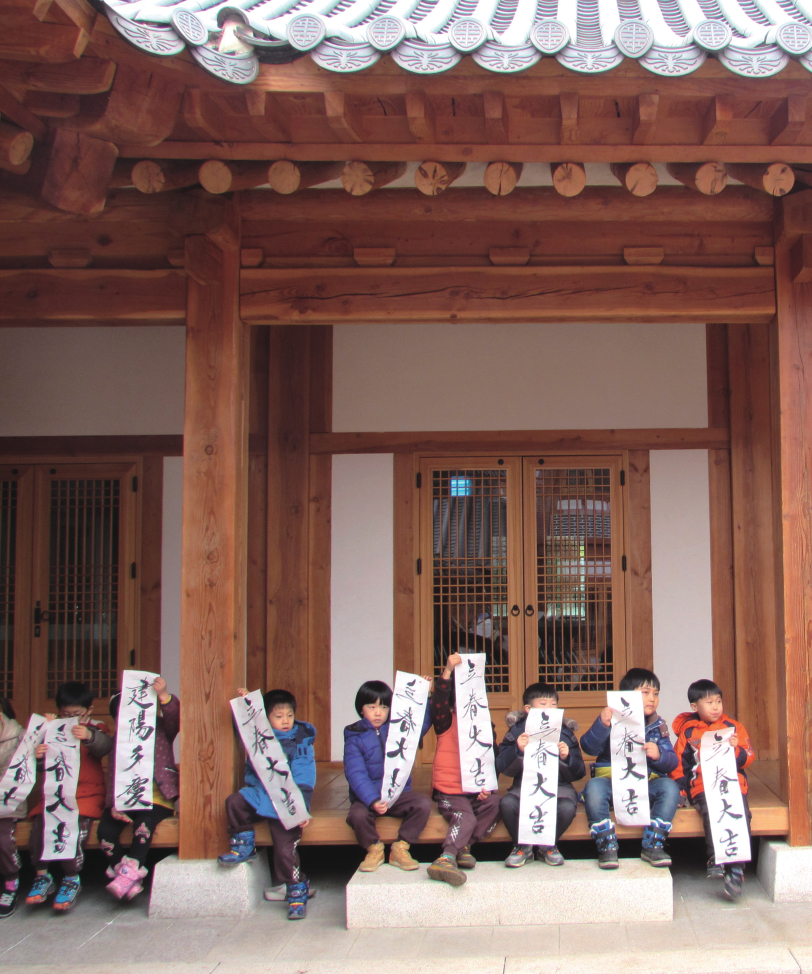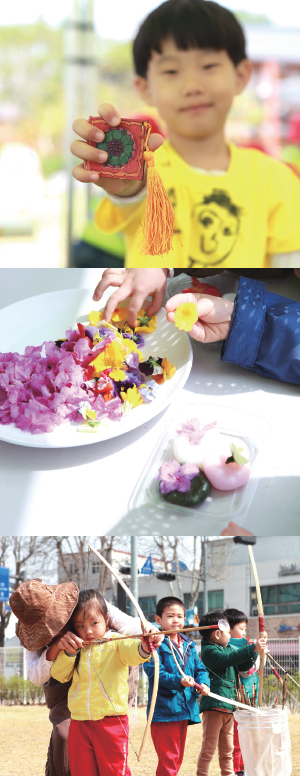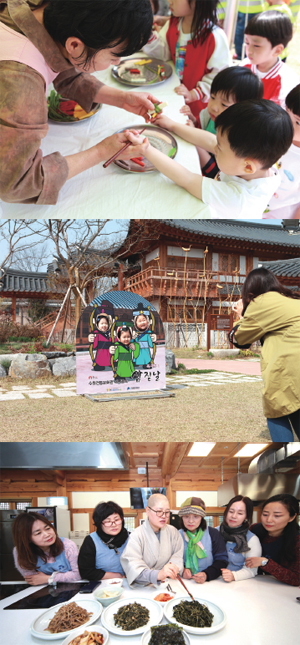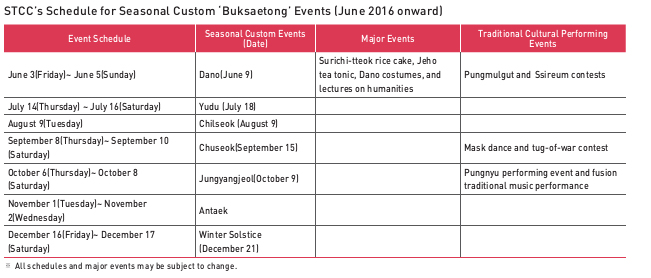Art&Space
15호 [북새통] 수원전통문화관 세시풍속 “북새통”

북새통 1 “입춘방"
[북새통]
수원전통문화관 세시풍속 “북새통”
글 최인애 전통문화사업부
수원화성 북문인 장안문 안쪽에 언제부턴가 화성행궁보다 더 예쁜 한옥 두 채가 들어섰다. 널찍한 앞마당에 텃밭까지 갖춘 이 한옥건물은 왠지 모를 신비감으로 입구에서 주저하는 방문객들도있지만, 실은 누구에게나 열려있는 우리 전통문화의 교육체험공간인 ‘수원전통문화관’이다.
작년(2015년) 3월 30일 개관하여 이제 갓 돌을 넘긴 수원전통문화관은 전통식생활체험관과 예절교육관 두 건물과 주변 공간을 아우르는 통합명칭이다. 교육시설로 건립되었지만 그 아름다운 자태에 이끌려 찾아오는 방문객들이 꾸준히 늘고 있다. 또한 바로 옆에 조성 중인 한옥기술전시관이 금년 중 완공되고 인근에 한옥건물이 지속적으로 들어서면서 수원화성 내 새로운 관광거점으로서 기대도 크다.
이에 발맞춰 수원전통문화관은 우리 전통문화를 계승하고 방문객들의 호기심을 자극하는 세시풍속 행사를 개관 2년차인 올해부터 매월 지속적으로 진행해하기 시작했다. ‘북새통’이라는 행사명은 ‘수원화성 북문에서 새롭게 펼쳐지는 전통문화체험’의 약자이다. 매월 세시풍속에 맞는 주제로 인문학 강의를 비롯하여 전통문화와 전통놀이 체험, 세시음식과 차 등을 직접 만들어보고 시식할 수 있는 행사가 준비되어 있다.
단오와 추석, 중양절 등 예로부터 큰 명절은 다채로운 공연과 시민참여 민속놀이 행사를 더하여 더욱 풍성하게 진행된다.

위에서부터 북새통 5 ‘만다라 그리기’
북새통 4 ‘화전만들기’
북새통 4 ‘전통놀이체험’- 다섯 달 5가지 재미 - 1월의 문배와 입춘방에서 5월의 초파일까지
- 입춘은 예로부터 한 해를 마무리하고 다시 새로운 해를 맞이하는 날로 24절기의 시작이다. 지난 1월 29일 ‘문배와 입춘방’을 주제로 세시풍속-북새통의 첫 문을 열었다. 유영숙 민화작가를 초청하여 입춘과 문배의 유래에 관한 인문학 강의를 진행했다. 또한 서울시 무형문화재 제38호 김영훈 이수자와 함께 봄을 알리고 한 해의 소망을 기원하는 문배와 입춘방을 만들었다. 우리 선조들은 이를 집 벽이나 대문에 붙여 새해의 나쁜 기운을 피하고자 했다.
2월에는 대보름 행사가 열렸다. 사찰음식 전문가 지견 스님의 인문학 강의와 오곡밥 만들기 체험 프로그램이 진행됐다. 오곡밥의 5가지 곡식(찹쌀차조붉은팥찰수수검은콩)은 풍년을 기원하는 의미가 담겨져 있다. 이 날 수원전통문화관을 방문한 체험객들은 직접 만든 오곡밥을 나누어 먹고 우리 선조들이 그러했듯이 화합의 뜻을 기렸다.
머슴날을 주제로 한 3월의 세시풍속 행사는 전통음식 전문가인 김수영 강사의 강의와 머슴떡 만들기, 나무솟대 만들기 체험으로 구성됐다. 머슴날은 본격적인 농사철에 앞서 한 해의 농사를 책임질 머슴들을 격려하고자 음식과 술을 양껏 대접한 날이다.
4월에는 강남 갔던 제비가 다시 찾아온다는 삼짇날 행사가 열렸다. 마른 나뭇가지에 새싹이 돋고 산과 들에 꽃이 피는 이 시기 옛 선조들은 무리를 지어 화전놀이를 갔다. 화전은 쌀가루 부침개에 꽃잎으로 모양을 낸 떡으로 수원전통문화관 방문객들도 야외에서 화전을 만들어보는 시간을 가졌다. 임시공휴일의 지정으로 황금연휴를 맞이했던 5월의 첫 주말에는 초파일 행사가 진행됐다. 수원전통문화관 앞마당에서는 만다라 그리기미나리강회 만들기연꽃차 시음 행사가 열려 시민과 관광객들의발길을 사로잡았다.

왼쪽부터 북새통 3 ‘나무 속대 만들기’ / 북새통 5 ‘만다라 그리기’ / 북새통 3 ‘전통차 시음’

위에서부터 북새통5 ‘미나리강회 체험'
북새통4 ‘삼짓달’
북새통2 ‘세시음식체험’- 일곱 달 7가지 도전 - 6월 단오부터 12월 동지까지
- 음력 5월 5일인 단오는 양기가 가장 왕성한 날이라 하여 설, 추석과 더불어 우리 민족의 가장 중요한 명절 중 하나였다. 예부터 단오에는 많은 의례가 행해졌는데 창포에 머리감기, 쑥과 익모초 뜯기 등의 풍속과 함께 그네뛰기활쏘기씨름 등의 민속놀이 등을 즐겼다. 또한 궁중에서는 제호탕옥추단애호단오부채 등을 신하들에게 하사하기도 했다. 6월 3일부터 5일까지 수원전통문화관에서 3일간 진행되는 세시풍속-북새통 단오행사는 전통문화한마당을 더하여 단오의 명성에 맞게 대규모 행사로 진행된다. 단오의 세시음식인 제호탕과 수리취떡 체험행사, 매실차 시음부스가 운영되고, 단오빔 체험과 인문학 강의도 준비되어 있다.
4일과 5일, 수원전통문화관 앞마당에서는 전통적으로 단오의 대표행사였던 씨름대회가 개최된다. 풍물굿패의 신명나는 공연과 일반인 참가자를 대상으로 어린이부여성부남자청년부 그리고 장년부의 우승자를 가린다. 대학 최강 경기대학교 씨름부의 시범경기와 탈락자들의 팔씨름 대회도 이벤트로 진행된다.
한여름에 진행되는 유두(7월)와 칠석(8월)행사에는 더위를 쫒는 음식과 차를 체험해 볼 수 있다. 1년을 손꼽아 기다리던 9월 한가위 추석에는 수확의 계절에 걸맞는 수원전통문화관만의 특별한 음식이 준비된다. 우리 민족의 대표 명절인 만큼 전통공연과 줄다리기 대회도 개최된다. 10월에 개최되는 중양절행사는 수원화성문화제와 연계하여 다채로운 체험과 공연행사가 진행될 예정이다. 11월에는 안택고사, 12월에는 동지로 1년 12달 행사를 마무리할 계획이다.
농사가 중심이 되었던 선조들에게 계절의 변화는 삶의 근본이었다. 해마다 같은 시기에 반복되어 전해오는 세시풍속은 농경사회에서 필요한 협동과 단합을 위한 축제였다. 이를 통해 우리 선조들은 고단했던 농사일 가운데 활력소를 찾았고, 이웃과 그리고 자연과 교감을 나눴다. 농업이 산업의 중심에서 벗어나면서 세시풍속의 의미와 행사도 점점 사라져가고 있지만 자연의 이치 속에 이웃과 더불어 살아가야 하는 우리의 삶은 그대로이다. 바쁜 일상 속에 수원전통문화관에서 삶의 쉼표와 우리 선조들의 지혜를 즐겨보면 어떨까.
Buksaetong: A Seasonal Custom Event of Suwon Traditional Culture Center
Written by : Choi In-ae(Traditional Culture Business Division)

왼쪽부터 Mandala drawing / Munbae(文俳) drawing / Humanities class
Two beautiful Hanok (traditional Korean houses), which were considered as more elegant looking than the Hwaseong Haenggung Fortress, were previously erectedinside Suwon Hwaseong Fortress near the Janganmun gate. The Hanok building, which even features an expansive front yard and a small-plot field, exudes a certain amount ofmysterious aura, thereby leaving the visitors hesitant in entering the place. However, the buildingis open to the public, and it houses the Suwon Traditional Culture Center (STCC), where traditional Korean culture education and experience programs are offered.
STCC has just turned one year since its opening on March 30, 2015. It accommodates the traditional lifestyle experience center, etiquette education center, and surrounding areas. STCC was originally intended for a traditional culture education facility, and it has attracted a steady number of visitors with its beautiful attractions. The Hanok Technology Exhibition Center is currently being built, and it is scheduled for completion within this year. These structures are continuously being built in the surrounding areas, and they are expected to become the new tourist hub within Suwon Hwaseong Fortress.
In line with such developmentthis year, STCC has decided to hold the seasonal custom event every month in order to promote the traditional Korean culture and to timulate thevisitors’ curiosity. The event known as “Buksaetong” (literally, “hustle and bustle”) comes from the acronym ofthe Korean expression ofa new traditional culturalexperience at the northern gate ofSuwon Hwaseong Fortress. Each month, STCC presents lectures on humanities that are suitable for the monthly seasonal customs, traditional culture, traditional game experience events, customary food, and the making and drinking oftea. Major traditional seasonal holidays,
including Dano, Chuseok, and Jungyangjeol, will feature brightly colored performing events and citizen participation in the folklore games.
Five Fun Activities in Five Months –Munbae and Ipchunbang (Spring Entry Message) from January to Buddha’s Birthday Holiday in May
Ipchun, the spring commencement date, is the first part of the 24 sub-seasons of the year in celebrating the new year and leaving behind the previousone. In January 29, we held the seasonal custom event of Buksaetong with the theme focusing on Munbae (originally known as the “royal paintings granted to the subjects”) and Ipchunbang (spring entry message). We invited the famous cartoonist Yu Yeong-suk to give lectures on Ipchun and Munbae. Together with the Intangible Heritage No. 38 course graduate, Kim Yeong-hun, we crafted Munbae and Ipchunbang to welcome the spring season and give our best wishes for the whole year. Our forefathers posted Munbae and Ipchunbang on the house walls andgates in order to expel the evil spirits and welcome a new year.
In February, we celebrated the Full Moon event, whereinthe temple food specialist Buddhist Priest Jigyeon delivered lectures on humanities, together with the making of Ogok-bap (five-grain rice). The five grains ofOgok-bap (glutinous rice, glutinous millet, red adzuki beans, glutinous sorghum, and black soybean) symbolize a prayer for an abundant harvest.
The visitors of STCC shared their own cooked Ogok-bap and paid their tribute toour forefathers’ harmonious spirits.
The March seasonal event theme ofFarm Servants’ Day featured the lectures by traditional food specialist Kim Suyeong, the aking ofMeoseom-tteok (rice cake ofservants), and the making ofwood poles with a bird atop it, which symbolizesthe act ofpraying for best wishes. On Servants’ Day, villagers hold a feast prior to a full-swing farming season in order to encourage the farm servants, as well as offer them plenty of food and liquor.
The April event featured Samjitnal Day, where in the swallows returned to the country after migrating to the warm southern region. During this time, when the trees sprouted new leaves and the flowers bloomed in the mountains and fields, the Korean forefathers joined the Hwajeon-nori game in groups.
Hwajeon is a rice pancake with flower patterns. The visitors of STCC tried to make Hwajeon outdoors.
On the first golden weekend holiday ofMay, along with a temporary holiday, an event was held to celebrate Buddha’s Birthday in the frontyard ofSTCC where in events, such as Mandara (Buddha) drawing, the making ofMinariganghoe (small rolls of boiled dropworts or scallions), and the tasting of lotus tea, appealed tomany citizens and tourists.
Seven Breathtaking Events in Seven Months – From Dano Holiday in June to Winter Solstice in December
Dano Holiday falls on May 5, according to the lunar calendar.
It is the day with the strongest Yang spirit, thereby making it one of Korea’s three major traditional holidays, together with the Lunar New Year Day and Chuseok holiday. Many events, such as washing the hair in aniris-soaked water, picking of mugwort and motherwort, swing riding, archery, and Ssireum (Korean wrestling), among other folklore games, have been executed on Dano Holiday. In addition, the king granted gifts, such as Jehotang (a tea tonic), Okchudan (an herbal medicine), Aeho (a tiger made of mugwort, bamboo, etc.), and Dano fans, to his subjects. For three days (June 3-5) on Dano Holiday, STCC will conduct a large-scale gala event by adding traditional cultural performing events to the seasonal customary event, Buksaetong.
The event will feature the making ofJehotang (a tea tonic), the making ofSurichi-tteok (rice cake with marsh plant and mugwort), and the tasting ofplum tea, as well as trying on Dano costumes and offering lectures on humanities. On June 4 and 5, STCC will hold Dano’s signature event, Ssireum (Korean wrestling) contests, on its front yard. Together with the exciting performance ofthe Pungmulgutpae Troupe, the performing contests will be held in the categories ofgeneral people,
children, women, male youth, and adults. The Ssireum Club ofKyonggi University, which is well known for its strongest Ssireum team, will demonstrate a Ssireum match, and the losers’ arm wrestling contest is also going to be held.
In the middle of summer, Yudu (July) and Chilseok (August) events will be held to allow the participants to taste heatlowering food and tea. During the Chuseok Holiday event in September, which is the month ofharvesting, STCC will present its wide array of unique food. We are going to conduct the representative Korean performing events and tug-of-war contests. In October, we are going to conduct the Jungyangjeol event, in association with the Suwon Hwaseong Fortress Cultural Festival, which will feature diverse experience events and performing events. In addition, we are going to hold the Antaek ritual in November and the Winter Solstice event in December, thereby wrapping up all of the year’s events.
For the ancient Korean forefathers, who were engaged in farming, the seasonal change was important for them. The traditional seasonal customs, which were repeated annually,
were festivals to encourage cooperation and unity among the agricultural society. They re-invigorated their energy amidst their hard working attitude toward farming, while mingling with their neighbors and enjoying nature. As agriculture gave way to other industries, the seasonal customs are gradually fading, but we still have to live peacefully with our neighbors and with nature. Please visit and enjoy the various traditional events at STCC.












